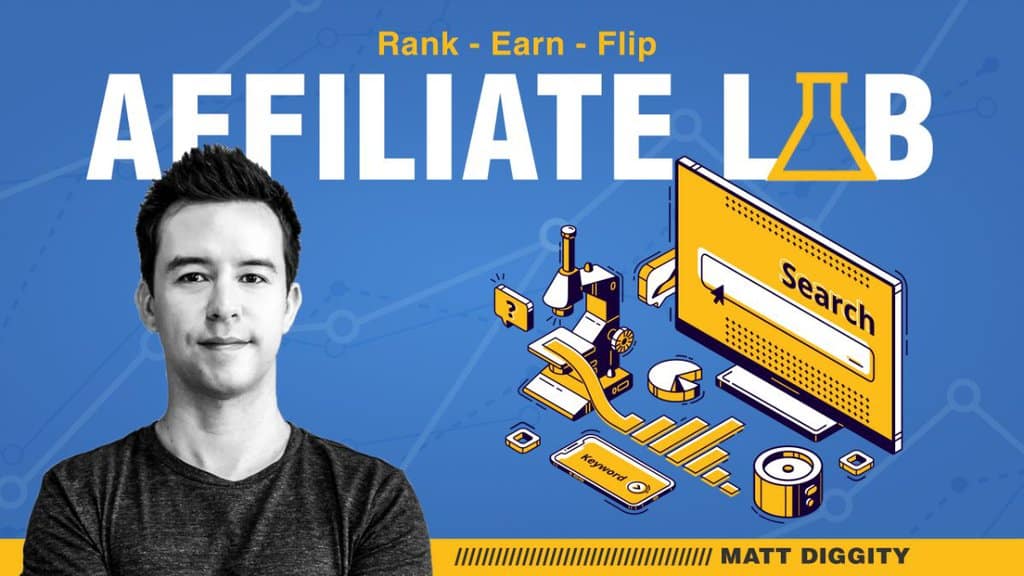WARNING: This is NOT a “6 tIPs oN HoW 2 cReATE A maSTerClaSS” BS article from some clown who’s never made an online course in their life.
I feel like 99% of people who write these articles online have 0 clue what they’re talking about. The following is real info from a real course creator who sells courses. Why does Google insist on ranking trash that doesn’t help readers? Who knows…
OK, rant over.

Creating an online course was the single best decision of my life. It was a total level-up for me in every way imaginable.
Was it hard work? Yes, it was hell.
Was it worth it?
HELL yes, it was.
My online masterclass has gotten me:
- Enough passive income to comfortably pay my bills each month (in Asia, but still …)
- A platform high enough to get conference speaking gigs
- More high-ticket consulting gigs than I ever had before
- Instant recognition at industry events (which is probably better than money, to be honest)
But creating a successful masterclass is NOT easy. I screwed it up the first time around. My first class was a crime against humanity and sent four months of my life down the tubes.
Don’t be like me.
Over the last few years, through trial and error, consultations, student feedback, and hiring professional marketing help, I’ve learned how to plan, create, market, and sell an online course the right way.
In this article, I’ll cover:
- How to create a legit online course step-by-step in plain English
- How to plan your course so it’s easy to record
- How to properly structure a course for maximum engagement and retention
- What you need to record your course (it’s less than you think)
- How to market your course like a BOSS without a massive budget
- Where real course creators host their courses (and where idiots host theirs)
Ready to take a deep dive? Me too. Let’s do it. Let me just grab a Pepsi 0 with lime first (I swear these have an addictive chemical in them).
How to Create a Masterclass in 5 Steps
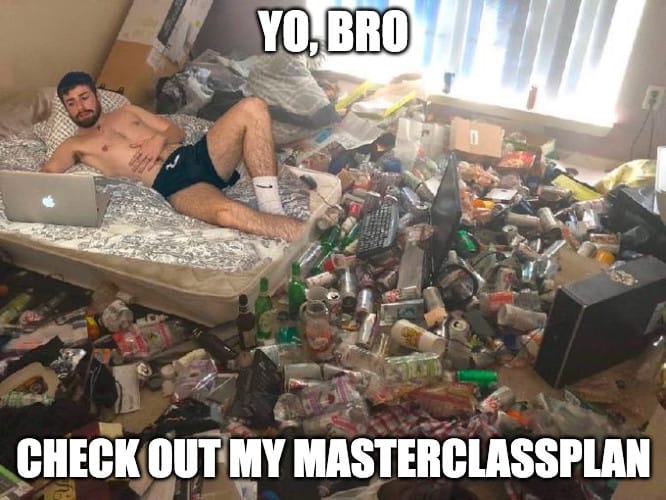
Like I said before, creating online courses is a s*** ton of work.
Like, “I’m going to break my laptop, move to North Korea, and NEVER work online again” type of work.
That’s why it’s so profitable and rewarding, though… very few people can do it well.
But if you break it down into small, manageable bites, it’s a lot easier to digest.
I built my first one in the most haphazard way you could imagine. My ADHD brain HATES processes. That was a huge mistake.
But I learned from my mistakes, listened to real experts, and did it the right way. Here’s the way I wish I’d done it the first time around. Follow this process and your course will CRUSH.
Step 1 – Find a Niche Topic Within Your Area of Expertise
Stop.
Rewind.
Let’s get a HUGE thing out of the way here first. Read this carefully:
You must be an expert to create a masterclass.
If you are not capable of giving real expert advice, you are not qualified to create a masterclass.
This is not an HoW dO i FiNd a COUrse TOpic article. It’s an article on making real, helpful online education full of high-value masterclass content.
OK, rant #2 over.
Creating a killer online masterclass starts with niching down within the broader niche of your expertise.
For example, instead of creating a Search Engine Optimization (SEO) course – there are millions. I could create a local SEO-for-tradesmen course.
In this course, I'd show tradesmen like plumbers, roofers, and construction companies how to beat their local competition.
See what I mean? Masterclasses are very focused.
Steph Curry’s masterclass isn’t about “how to play basketball.” It’s about “how to shoot a basketball like Steph Curry.”
Oh, OK, Karl. “Just find a masterclass topic.” How do I do that?
Good question.
Here’s what I would do…
Start by doing general research across your niche/industry and see where the gaps are.
Always ask yourself these questions:
- Can I improve on this with more expertise or newer data?
- Can I niche down even further?
- Can I offer an extra service that adds even more value to the course?
Here’s a great example of what I’m talking about:
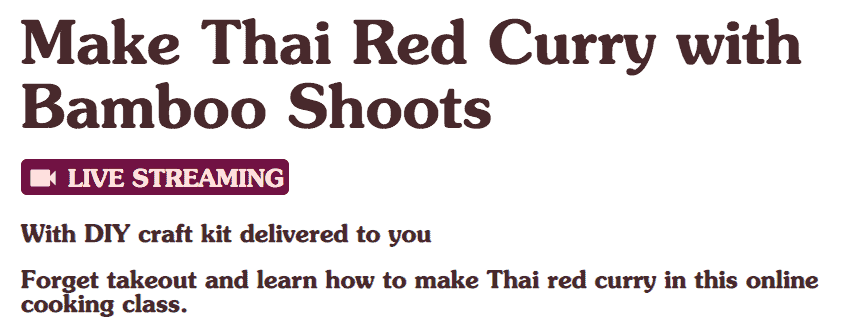
How many cooking classes are there? Trillions?
Everyone has a cooking class online these days. My dog just launched hers on Udemy.
But this one is niche as hell AND it offers added value by sending you the cooking kit. See how next-level this is?
It’s LESS work for them – they’re only teaching ONE dish – and they can still charge a premium because the DIY kit adds so much value. This course is $129! How easy is it to teach a single dish and send a box with a few ingredients?
I’m kind of craving some curry right now after going through that page.
Step 2 – Plan Out Your Content and Structure It Properly

I just bought that Thai cooking course, by the way (they don’t deliver kits to Thailand, though – shocking!).
OK, this is where I screwed up royally the first time.
When most people begin planning their class, they think they can just sketch a bunch of ideas out and start recording.
Wrong.
You CAN, but you will regret it when you have to burn your course and start again. Ask me how I know…
Here’s how to plan and structure high-quality educational content properly and easily.
Break out a Google Doc and start jotting down notes. Start with the end goal of the masterclass and build from there. Choose an easy topic like becoming a freelance writer (sounds like a terrible job).

Now, think of all the high-level skills they’ll need to accomplish this goal. By high-level, I mean the general key skills and NOT the nitty-gritty details of each.
For example, a high-level skill would be “how to find clients” and not something more detailed like “the best platforms to find clients.” Got me?
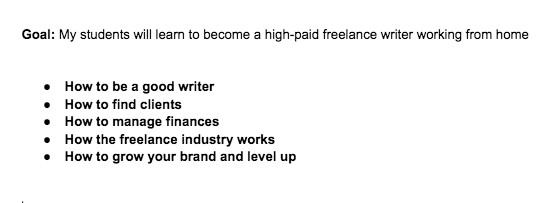
This is a very basic version, but I think it makes my point. A successful freelance writer needs to know all of these things to succeed. This is going to be the foundation of your masterclass content.
Next, break each one down into smaller skills/details. Those are going to be your individual video tutorials (for the most part).
Like this:
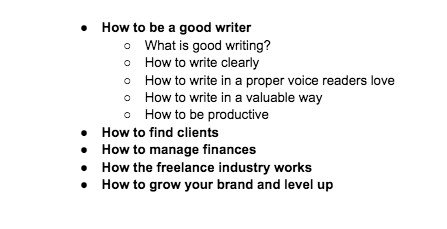
Do this for ALL of your key skills.
From there, you need to structure it properly. If you don’t, students will HATE you and they won’t finish the course. That means no testimonials, affiliates, or future sales.
Get this right or you will regret it. Again, ask me how I know.
I highly suggest using a very simple structure if this is your first course. Online courses need a very simple, straightforward structure or you will lose a student’s interest.
Start with an introductory module where you cover the following:
- Who you are
- Your qualifications
- Your background story
- What they’ll learn in this course
- The result of this course (their transformation)
- Proof (case studies, famous clients, data, or whatever you can muster that proves you are legit)
Next, follow a simple module/section/lesson format like this:
- Module 1: The Basics of Freelance Writing
-
- Section 1: Quality Writing
-
-
- Lesson 1: What is quality writing?
- Lesson 2: What everyone gets wrong about quality writing
- Lesson 3: 3 keys to writing great web content
-
Each section should have a wrap-up video (1-2 minutes long) where you summarize the key info learned in each section.
Step 3 – Create Your Content
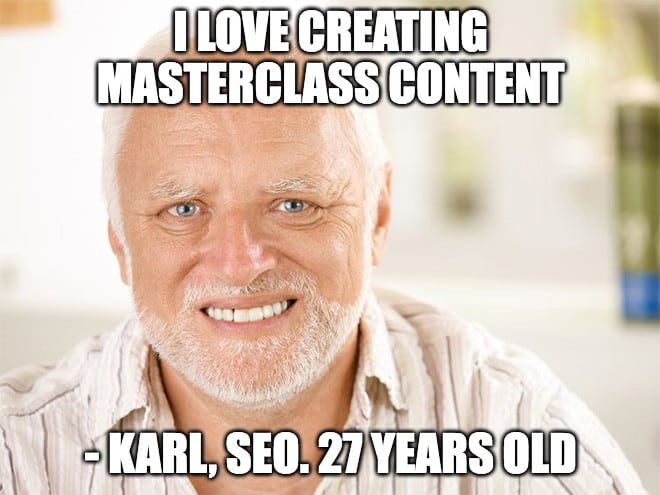
It’s time to create content.
Most online content falls into one of three categories:
- Slideshares or screen shares: Where you just record your screen and show either a slide presentation with information or a live demo of some skill online (common in courses for digital marketing or other digital skills).
- Interview-style videos: You know these. Some guy sitting at a mic staring into the camera babbling about God-knows-what.
- Demo videos: This is where you show the student how to do something live. Examples include cooking a dish, showing a yoga pose, or training a dog.
This is why planning is so important.
When you brainstorm and structure your masterclass content, you’ll know exactly what you’ll need to make when it’s time to create content.
Just follow along and go lesson by lesson from your plan above. If you get stuck, just use the problem->solution format. I used this in 90% of my videos, and students loved it.
In the problem -> solution format, most lessons look like this:
- Intro: In this video, we’ll talk about (topic)
- What is (topic)?: Describe (topic) in plain English
- Problem: Most people are wrong about (topic). Here’s how …
- Solution: How to do it right
- Demonstration: Show exactly how to do it right
- Reiterate: Quickly sum up the topic, problem, and solution
Of course, this isn’t gospel. It mostly works for skills-based training, but it’ll help in a pinch. There’s nothing worse than a lesson with 0 structure where the lecturer just babbles about nonsense for 30 minutes.
Tips for Creating Your Masterclass Content
- Keep videos brief: Optimal video length is somewhere in the 4-6 minute range. Live demo videos can be longer as long as they’re value-packed.
- Always think about the end goal: Your course goal is its reason for living. Always refer back to it at all times. When you teach your students something, explain how it relates to that goal and how it’ll help them achieve it. With my writing course example, it might be something as simple as “finding your voice will help you stick out in a sea of thousands of freelance writers. That’s how you’ll get noticed and land high-paying clients.”
- Add in activities: Masterclasses are a bit different from typical online courses. They are expected to be more “live demo”-based and contain activities. So, make sure to include activities for students to do after key lessons and make demo videos of you doing them. In my writing course (I really should make one… ), it could be like, “Go cold pitch 5 clients before your next lesson. And here’s a video of me doing it!”
- Mix things up: Keep videos brief, but occasionally add longer “discussion” or “demo” videos to keep students on their feet.
- Be FUN: For the love of God, nobody wants to fall asleep 3 minutes into a course. Add memes, make jokes, add cuts to funny video clips – whatever it takes to keep students on their toes. Dry courses are a nightmare and your completion rates will be awful.
NOTE: I’ve only addressed videos here because that’s the type of content you should use. Extras like PDFs, articles, or small text-based lessons are fine, but a masterclass MUST be video-based.
Step 4 – Choose a Course Platform
An online course platform is a dedicated platform for your course videos. The advantage of using one of these is that, unlike general video platforms like YouTube, course platforms include crucial course marketing and hosting features like:
- Video hosting
- An affiliate program
- A pre-made course structure to follow
- Analytics
- Student profiles
- Payment processing
A good platform will easily multiply your business by 10. A bad one will stifle growth, piss you off, and ruin your business before you even start.
I chose Teachable because it had “Teach” in the name. Worst mistake of my business career. Do NOT DO IT.
You need a platform with the following:
- Ease of use: You don’t want to struggle for weeks just figuring out how to upload a damn video. You need something seamless with the most important stuff one click away.
- Power to scale: Hosting videos and asking for money ain’t going to cut it. You’re going to need the real juice. Affiliates, email marketing, webinars, landing pages, and all that good stuff. If a platform doesn’t have it (Teachable), RUN.
- Fair pricing: I don’t mean “cheap.” I mean a fair price for what you get. If something is $200/month but can multiply your business by 10, it’s fair. If it’s $200/month and doesn’t do anything but host your videos, it’s BS (Hey Teachable…).
In my 5+ years in this business, everyone I’ve ever met uses one of the following 3 platforms (myself included). Each one is ideal for a different customer. Check it out:
1. ThriveCart – The Best Overall Platform for New Course Creators

I love ThriveCart. It’s the platform I use now. I’d marry it if I could.
Switching from Teachable to ThriveCart has changed my business. I don’t have the exact numbers handy, but it’s somewhere in the neighborhood of 4-5x growth just from switching platforms.
ThriveCart is dead easy, infinitely customizable, and costs only ~$700 FOR LIFE.
You just pay once, and you’ll get a platform with:
- Amazing speed
- No restrictions
- A dedicated teaching platform
- High-level course enrichment
- Advanced features like course bundles and team members (staff)
- High-converting landing pages, one-click upsells, and add-ons all backed by real data
- A legit affiliate program
ThriveCart does require a few integrations here and there, but it offers infinite flexibility instead of putting you in a straitjacket and sucking the life out of you.
But the best part is it gives you everything you need to build a course business for just $695 FOR LIFE. Pay now and you’ll never pay again.
2. Kartra – The Best All-in-One Platform

Kartra is a godsend for new course creators because it puts everything you need to build and grow your course right into one place.
Instead of 15 different tools and subscriptions, you get one dedicated platform that does it all – no extra subscriptions, no integrations, no nothing.
Instead of making your life harder – like most tools – Kartra makes your life 10 times easier. You’ll never need to learn a new tool or switch to a new platform. And everything you need to get off the ground costs only $99.
I like how all key features are included in the basic plan, just with certain limitations. That’s fine because you won’t need to upgrade until you’re ready to. By then, you’ll have the money and WANT to upgrade.
The only reason I don’t use Kartra is because I’ve been in this business long enough that I know exactly what I need to do, and I need more freedom to use different tools. If I were just starting, I’d get Kartra for sure.
3. Kajabi – The Best Course Platform Ever Made
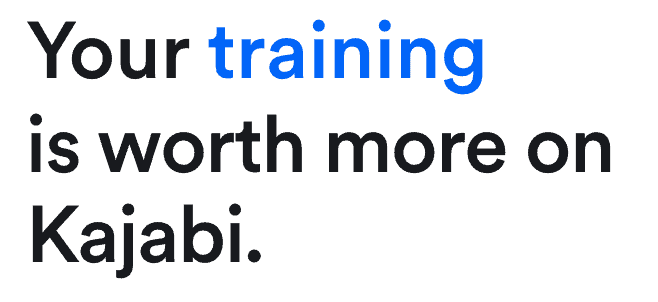
Kajabi is to course platforms like Michael Jordan is to the NBA: the G.O.A.T. – Greatest of All Time.
It’s got everything you could need to grow an online empire including podcasts, communities, custom apps, and built-in marketing funnels (with landing page templates).
Kajabi is what 7-figure masterclass creators use to grow a massive brand. There’s nothing like it.
It’s EXPENSIVE, and I guarantee that it’s overkill for 99% of the people reading this article. But if you have big dreams and want to start podcasting and growing an online community, Kajabi is for you.
Step 5 – Choose a Business Model

Choosing the right business model could be the difference between making $5,000, $50,000, or even $500,000 on your course.
Here’s why:
Imagine you’re selling a masterclass on cybersecurity to a large corporation. First off, lucky you. I hate you.
Secondly, you have the perfect opportunity to offer multiple different payment models, some more profitable than others.
Most creators just choose a one-time fee. Pay me $500, here’s my masterclass, enjoy.
But that’s a huge mistake when you have certain types of clients. Now some bigwig pays $500 and gets to upskill their whole team for cheap.
What if you offered seat licenses instead? Now the company has to pay for your course for every person on their team. Better yet, what about a subscription, where they pay monthly or yearly for unlimited access?
What I’m trying to say is that there are tons of different pricing models. And depending on your type of course and clientele, some options might be better than others.
Let’s cover the most popular ones:
- One-time fees: Old and faithful. The industry standard. This is where someone pays a flat fee, gets your masterclass, and gets lifetime access. I recommend this for simpler courses aimed at individuals. They’re best for static knowledge transfers like “how to cook Thai food” or “how to build a website for beginners.”
- Individual seats licenses: This is when you sell “seats” to your course for individuals, usually within a team. It’s more for B2B clients. For example, if you have a training course for small businesses, they buy a seat for each of their employees to take it.
- Subscriptions: The greatest thing since cookie dough ice cream. This is the Holy Grail of all online course creation. If you can turn your master class into a subscription service, you’re gold. It’ll require more things like a community, web conferencing, or extra certification services to justify the price, though.
- Memberships: Memberships are when people pay monthly to subscribe to your class, and you consistently deliver new material at regular intervals. A good example could be a fitness course that provides regular coaching, diet plans, and instructional videos every month.
NOTE: Some creators make a free class where students get a free account in exchange for giving their email. This can be a good way to build an audience for the long-term. You'll grow your email list and then sell the paid courses through that.
The Complete Online Masterclass Guide

What Is a Masterclass?
A masterclass is a super comprehensive online course on a niche topic where an expert thoroughly covers their topic from start to finish as well as provides hands-on learning, “homework,” and sometimes even ongoing support.
In some cases, the creator adds additional value by including a Facebook group, Facebook Live or YouTube Live sessions, a monthly newsletter, or an online community where they encourage student participation.
In theory, a masterclass should be able to take a member of the target audience and give them all of the information and guidance they need to master a subject (assuming they put in the work).
They can be brief or super long depending on the subject and style of instruction. In my experience, they usually consist of at least 4-5 hours of videos plus supporting documentation and “homework.”
An online masterclass could be on anything from professional skills like public speaking to hobbies like writing, yoga, or cooking. I once took an art masterclass just for fun. Hated it…
What Should a Masterclass Include?
A masterclass usually contains several hours of video content plus at LEAST one of the following:
- Study materials for each lesson like worksheets, PDFs, and notes
- Office hours where the instructor answers student questions
- Q&A sessions
- Webinars
- Supporting blog posts or audio
- Assessments like quizzes
- A support group on Facebook or elsewhere
“Masterclass” is a very loosely defined term. For some, a masterclass could mean a standalone workshop. For others, it could be a series of live events.
Usually, however, it’s an entire masterclass taught by an expert instructor which also includes supporting work like listed above.
Who Can Make a Masterclass and Who Are They For?
Anyone with in-depth knowledge of a topic can start creating a masterclass. All you need is the knowledge, the right audience, and the knowledge of how to market a course and grow your brand.
Who are they for? That’s a pretty tough question to answer.
A masterclass can be for literally anyone interested in the topic you offer. The key is finding the right target audience.
A masterclass can be for:
- Beginners looking to break into an industry
- Professionals looking to skill up and get a promotion
- Business owners wanting to grow their business
- Anyone with an interest in the topic who wants to take a class for entertainment or recreation
Again, it all comes down to the target audience you’re after.
- Who are they?
- How much disposable income do they have?
- What goal are you helping them reach?
- What value are you providing to their lives?
- Is there a transformation you can offer?
- How much of an expert in your niche are you and what can you teach them?
How Much Does a Masterclass Cost?
Masterclasses should NOT be cheap. A masterclass is not an introductory class.
Prices will vary depending on a few factors:
- Your audience
- Your competition
- Your value
- Your marketing
- The ending transformation for the student
I’ve seen prices ranging anywhere from $500 to $10,000 or even more. It all depends on the value potential customers see in your class.
You should start by doing general market research and seeing what the competition charges. From there, assess where you stand in that market.
Do you offer more value? Do you have a bigger profile? Are you better at marketing? This will determine how much you can charge.
My best advice is to start with a lower price, get some feedback, and grow from there.
How Long Should a Masterclass Last?
Again, nobody knows for sure.
Classes on Masterclass.com usually go for 2-3 hours. But those are a different breed.
Most of them are more theoretical and not really a true masterclass. If you’re doing a legit masterclass that teaches people a high-value skill, your class could last anywhere from hours to days to weeks.
It all depends on which kind of masterclass you’re offering. If it’s about learning a valuable skill and gaining certification, it could be days and days of videos, workshops, and evaluations.
If it’s something like “cooking Thai food for fun,” then it could be an hour.
Anyone who tells you there’s a set time limit or time frame for these types of classes is lying.
How to Market Your Masterclass
Now it’s time to start promoting your masterclass. Please don’t just start running ads for your masterclass landing page. If you want to light money on fire, be my guest.
If you want to get a ton of sign-ups and make more money than 90% of course creators, follow my advice. I’ve learned it the hard way.
Step 1 – Set up a Masterclass Sales Page
Before you even start thinking about building a funnel, get your masterclass sales page set up. Do it now.
I don’t care if it’s a live class, a pre-recorded workshop, or just you dancing and telling people to dance like nobody is watching.
Seriously, just do it.
This “landing page” acts as the central command for your entire masterclass operation.
A successful masterclass landing page contains the following:
- A great headline
- Your story
- The transformation a student gets
- A live look inside
- Key details about your masterclass
- The benefits prospective learners get from finishing your masterclass
- A guarantee (optional but preferred)
- An opt-in form so people can sign up for emails from you (an opt-in form is just a pop-up where people give you their name and email)
Setting your landing page now gives you an immediate way to bring in sales, and it also gives you a destination for your sales funnel. Let me explain that now…
Step 2 – Start Building Your Sales Funnel
A sales funnel is a step-by-step process that turns a new lead into a customer.
At the top of your funnel, you have basic promotional material that makes a prospective customer aware of your class and the benefits it could bring them.
In the middle, you have more educational material that presses hard on their pain points and educates them on your solution. Then, the final step is making the sale.
Think of it like this:
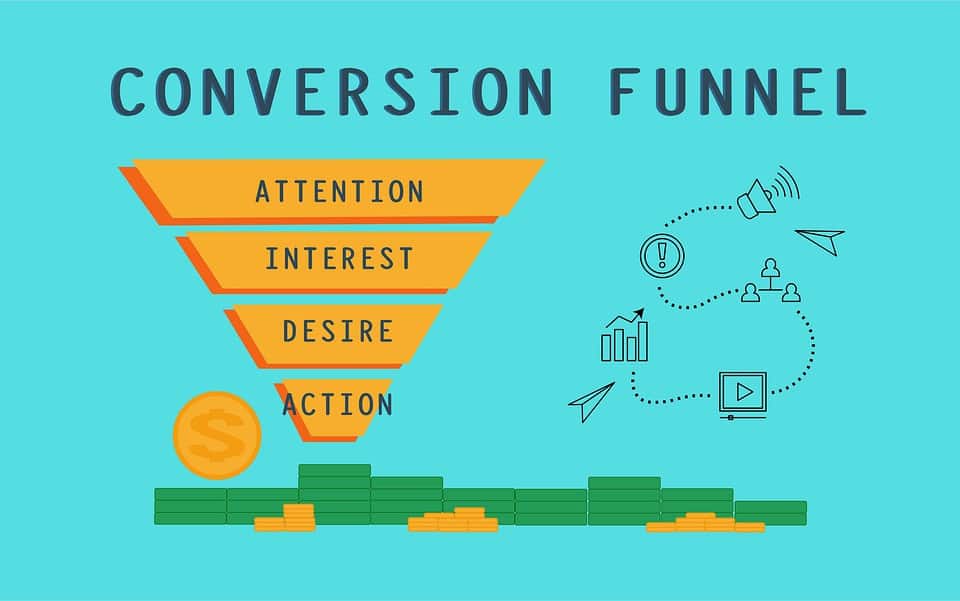
This is a very basic description, but it’ll have to do for now. There could be an entire masterclass on funnel building… Hmm, I really should make one.
For your masterclass, I suggest starting with a very basic “lead magnet.” A lead magnet is a simple downloadable that users get in exchange for their email address.
Another lead magnet could be a direct link to a video where you give free advice.
For example, if you’ve got a cooking masterclass, you could offer something like “My top 10 Thai recipes to make at home” or “3 secrets of great Thai cooking.” I’d get that lead magnet if you offered it.
If you’ve got some marketing chops, consider offering a free webinar where you talk about your topic on live video.
Again, sticking with this Thai food example, you could do a 30-minute event where you cook some Thai dishes and serve them to friends.
Once you get their email address, you need to start using email marketing to gently lead them toward your masterclass. There are tons of free email marketing tools, so don’t worry.
Anyone who downloads your lead magnet will be interested in your masterclass, so keep sending them an email sequence full of valuable content.
At the end of your funnel, offer your masterclass at a discount. Something like, “Hey, you’ve seen how much value my teaching has. Now you can have the masterclass at 40% for a limited time!”
Step 3 – Promote Your Masterclass Organically
This is one of the most neglected steps in all of online marketing. Everyone wants to run ads or bombard people with emails. Nobody wants to work.
This is where the real money comes from, though.
Growing your platform organically around the web through podcasts, posting on other people’s websites (guest posts), and doing SEO where you target specific keywords related to your class.
In addition, you can even grow your own following through videos, Facebook groups, and Twitter which is how you’ll make real money.
Do a Google search in your niche and see where similar masterclass creators have appeared. Send them an email showing them your credential, materials, and pages, and ask for a similar speaking gig.
Start your own social media group on Facebook, an online community platform, Rumble, or Twitter. I don’t care where. Start posting about your topic and find interested people.
This is how I took my course to the next level. Don’t neglect it!
Examples of Masterclasses From Around the Web
Optimize Your Way to the Top – Kyle Roof
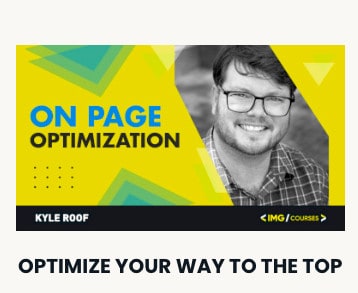
Kyle Roof is an SEO boss, and he performed 400 tests to discover what Google cares about. He turned that into an action-packed SEO class showing you exactly what helps rank a website and what doesn’t.
Notice how this isn’t a “beginners” course, but more of a niche class on real ranking factors that will instantly help you rank a website. Remember, a masterclass doesn’t have to be long and boring.
Web Copy Masterclass – Kevin Meng

Kevin Meng’s Web Copy Masterclass is a writing class showing you how to write sales pages and product reviews that convert.
Unlike traditional copywriting classes, his course shows you data-backed ways to increase sales when selling products online. Again, super niche and very concise!
Steph Curry’s Masterclass
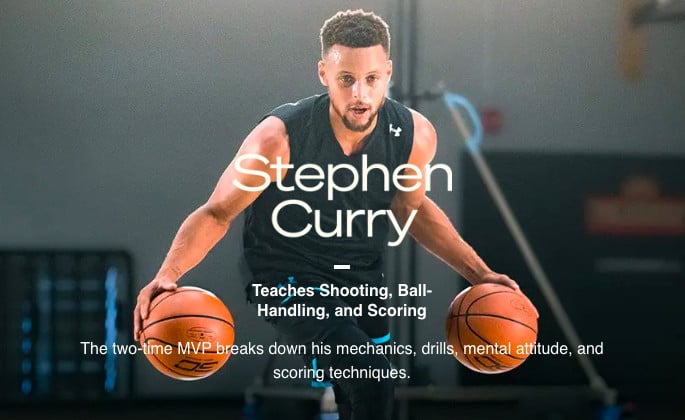
The best shooter of all time teaches you how to shoot, handle the ball, and score. You really can’t get a better value proposition than that. Come on, man, it’s Steph!
Yum-O Cooking Camp – Rachael Ray

Here’s a great example of a hybrid-style class that is a one-part Zoom session and a one-part workshop.
This engaging masterclass is hosted by Rachael and other celebrity chefs. It not only teaches kids how to cook but also gives them recipes to follow and provides interactive activities for the whole family.
Upskill – Essential Web Developer Course
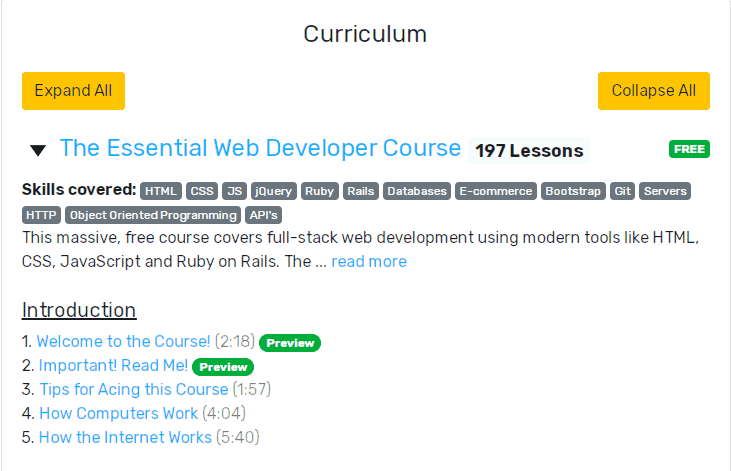
If I ever decide to quit SEO and become a developer, I’d start with this course. It’s so comprehensive, well laid out, and free… if you pay about $120/month for unlimited access to Upskill.
If you want to structure your masterclass like a pro, just check this out and be amazed. It’s an excellent example of structuring a class, easy to follow, and even includes some tips for improving outcomes in the introduction. Great job.
So, What’s Next?
You now have the following tools:
- Knowledge of how to build and structure a successful masterclass
- An understanding of basic marketing
- How to find your audience of students and gain proof of concept
And you even know some of the best tools for hosting your course.
What’s next is to learn to make your class, then take a deep dive into marketing and pricing your course.
Check out these guides on how to find the perfect price for your class and market a masterclass like a boss.
Good luck!
How to Create a Masterclass F.A.Q.
Q: What makes a class a masterclass?
A: The difference between a class and a masterclass is that a masterclass has a very narrow focus and is taught by an expert with a large brand. It covers not only key skills but also the theory and the creator’s story, sometimes providing ongoing support to students. There are a lot of similarities between the two, but a masterclass offers a celebrity factor and support that most students can’t get in a typical classroom.
Q: What is the format of a masterclass?
A: Masterclasses are formatted similarly to the typical course or standard university class except with a few key differences. For one, a masterclass typically focuses on explaining the creator’s story to the reader and may also include live workshops, in-depth supporting documents, Q&A sessions, and ongoing student support.
Q: How do you conduct a masterclass online?
A: There are a few ways to conduct a masterclass online. You can do a live masterclass, where you meet with students over Zoom (you’ll need Zoom premium). You could also create a course, pre-record videos, and have students pay for lifetime access. Other classes tend to be a series of workshops at regular intervals. Great news: As long as you have valuable content and know how to get sign-ups, you can conduct a masterclass any way you want.



